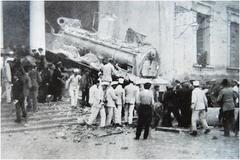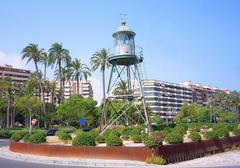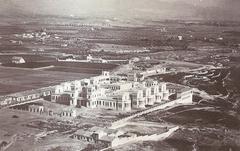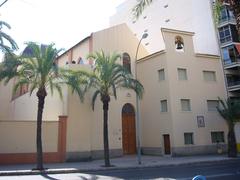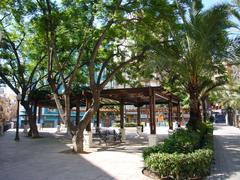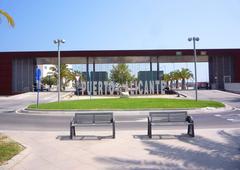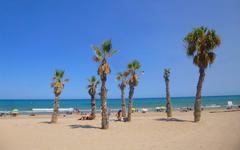
Sangueta Alicante Spain Visiting Hours, Tickets, and Travel Guide
Date: 04/07/2025
Introduction: Sangueta, Alicante – History and Significance
Nestled along Spain’s spectacular Mediterranean coast, Sangueta is a historic neighborhood within the vibrant city of Alicante. It offers visitors a captivating blend of ancient heritage, cultural richness, and urban transformation. Sangueta’s story stretches from prehistoric Iberian settlements and Roman prosperity as Lucentum, through Moorish influence and the Reconquista, to its present-day role as a dynamic Mediterranean enclave. Key landmarks such as Santa Bárbara Castle, the Archaeological Museum of Alicante (MARQ), and the bustling Playa del Postiguet are all within walking distance of Sangueta’s atmospheric streets (Alicante.com; PlanetWare).
Currently, Sangueta stands at the forefront of ambitious urban regeneration, focusing on sustainable mobility, green spaces, and inclusive community planning. The neighborhood’s evolving identity allows travelers to experience both Alicante’s renowned festivals and gastronomy—such as arroz a banda and turrón—and the dynamic process of urban renewal (La Vanguardia; Todo Alicante).
This detailed guide presents essential information on visiting hours, ticketing, historical sites, accessibility, and travel tips, empowering you to plan an unforgettable visit to Sangueta—Alicante’s storied and culturally vibrant seaside enclave (splendidlyspain.com; Alicante Plaza).
Table of Contents
- Introduction
- Ancient and Medieval Roots
- Historical Significance within Alicante
- Sangueta in the Modern Era
- Key Historical Landmarks
- Exploring Sangueta: Urban Regeneration, Heritage, and Visitor Guide
- Top Sights: Hours, Tickets, and Travel Tips
- Visiting the Sangueta Monument: Hours, Tickets, and Insights
- FAQs
- Conclusion
- References
Ancient and Medieval Roots of Sangueta and Alicante
Prehistoric and Iberian Foundations
Alicante and Sangueta have been inhabited since at least 1000 BC. Archaeological sites, such as Tossal de Manises, reveal early Iberian settlements known as “Akra Leuke” or “White Summit,” setting the groundwork for the area’s enduring Mediterranean significance (Alicante.com).
Roman Era: Lucentum and Maritime Prosperity
The Romans renamed the city “Lucentum” (“Place of Light”) and introduced sophisticated urban planning, including baths and a port that fostered Mediterranean trade. Lucentum’s port was central to economic and cultural exchange in Hispania (Alicante.com).
Moorish Influence and the Birth of Al-Laqant
With the fall of Rome, Moorish dynasties took over, calling the city “Al-Laqant.” They improved trade, agriculture, and irrigation, creating a cosmopolitan culture. Sangueta, near the coast, likely functioned as a hub for fishermen and merchants (Alicante.com).
The Reconquista and Christian Rule
In the 13th century, King Alfonso X of Castile reclaimed the city, renaming it “Alicante.” The imposing Santa Bárbara Castle was constructed atop Mount Benacantil as a defensive stronghold, which remains a prominent city landmark (Alicante.com; PlanetWare).
Sangueta’s Historical Significance within Alicante
Maritime and Urban Development
Sangueta’s waterfront location made it essential for maritime activities. Traditionally a working-class neighborhood, it supported fishermen, dockworkers, and artisans who were critical to Alicante’s economy (Mapcarta).
Defensive and Strategic Importance
Sangueta’s coastal position left it exposed to pirate raids and other invasions. Defensive structures such as Santa Bárbara Castle and city walls shaped the area’s urban landscape (Alicante.com).
Growth in the 18th and 19th Centuries
The 18th-century economic boom, driven by exports like wine and almonds, saw Sangueta support commercial growth. The Esplanade of Spain and other civic buildings symbolize this prosperity (Alicante.com).
Sangueta in the Modern Era
20th Century Transformation
Alicante’s port was a Republican stronghold during the Spanish Civil War, and Sangueta, near the waterfront, experienced both wartime challenges and postwar rejuvenation. Later, the rise of tourism transformed Sangueta into a more integrated urban neighborhood (Alicante.com).
Contemporary Sangueta: Tradition Meets Modernity
Today, Sangueta’s narrow lanes and traditional homes coexist with modern amenities. Its proximity to major attractions makes it an ideal base for visitors (Mapcarta; PlanetWare).
Key Historical Landmarks Near Sangueta
Santa Bárbara Castle
- Hours: Daily, 10:00 AM–8:00 PM (seasonal variations may apply)
- Admission: Free; optional guided tours (€6)
- Highlights: Islamic origins, Renaissance renovations, panoramic city and sea views
Archaeological Museum of Alicante (MARQ)
- Hours: Tuesday–Saturday 10:00 AM–7:30 PM; Sunday 10:00 AM–3:00 PM; closed Mondays
- Admission: ~€3 (discounts for students/seniors)
- Exhibits: 100,000 years of history, from prehistory to the Middle Ages
Playa del Postiguet
- Access: Open year-round, free public beach
- Features: Lifeguards in summer, accessible, with nearby cafés
Exploring Sangueta: Urban Regeneration, Cultural Heritage, and Visitor Guide
Discovering Sangueta: A Neighborhood in Transition
Sangueta is strategically located between Playa del Postiguet and the slopes of La Cantera, framed by the Serra Grossa mountain range and Alicante’s marina. Historically, it served as a mixed-use area with residential, industrial, and port activities. Although underutilized for years, Sangueta is now a focus of ambitious urban regeneration efforts (La Vanguardia).
How to Visit Sangueta
- By Tram: La Marina station is the closest stop.
- By Bus: Several city buses serve the area.
- On Foot: A 10-minute walk from the city center and Playa del Postiguet.
Accessibility: While improvements are underway, some streets may be uneven or under construction. Check current conditions if you have mobility needs.
Sustainable Urban Regeneration
Sangueta is a model for sustainable urban development, with priorities including:
- Reduced car traffic and improved pedestrian/cyclist routes
- Creation of parks and green spaces
- Enhanced connectivity with the city and coast
- Community participation in planning (Todo Alicante; Alicante Plaza)
Local Heritage and Community
Sangueta’s identity is rooted in its working-class and maritime history. Community activism has led to court-mandated urban planning, emphasizing civic engagement (Cadena SER).
Visitor Tips
- Safety: Generally safe, but remain cautious in construction zones and avoid poorly lit areas at night.
- Amenities: Limited in Sangueta itself; La Marina offers more options.
- Guided Tours: Some city tours include Sangueta.
Discover the Best Historical and Cultural Attractions in Sangueta, Alicante
Santa Bárbara Castle
A hilltop fortress with origins in the 9th century, offering commanding views and exhibitions on Alicante’s history (splendidlyspain.com).
Barrio de Santa Cruz
A picturesque quarter with narrow, flower-adorned streets—especially lively during Semana Santa.
Explanada de España
A palm-lined promenade with over six million marble tiles, perfect for evening strolls.
Co-Cathedral of Saint Nicholas
A Renaissance masterpiece with a striking blue dome, open for visitors most days.
Mercado Central
A bustling market ideal for sampling Alicante’s culinary specialties.
Natural Attractions and Beaches
- Playa del Postiguet: Golden sands and calm waters, fully accessible (Barcelo Guide).
- Playa de la Albufereta: Quieter beach, popular with locals.
- Parque de Canalejas: Urban park with playgrounds and fountains.
- Tabarca Island: Day-trip destination for snorkeling and historic charm.
Museums and Cultural Venues
- MARQ: Showcasing Alicante’s history from prehistory to modernity.
- Las Cigarreras Cultural Centre: Contemporary arts venue.
Gastronomy and Local Experiences
Savor local dishes like arroz a banda, paella alicantina, jamón ibérico, and turrón in nearby tapas bars. Consider a food tour at Central Market for a deeper dive into Alicante’s culinary scene (splendidlyspain.com).
Festivals and Events
- Hogueras de San Juan: June bonfires and celebrations citywide.
- Semana Santa: Traditional Holy Week processions.
Practical Visitor Tips
- Getting Around: Excellent tram and bus connections; walking is convenient for most sights.
- Accommodation: Book early during festival periods.
- Accessibility: Many sites are accessible; check details for historic attractions.
- Local Customs: Expect late lunches and siesta closures.
Visiting the Historic Sangueta Monument: Hours, Tickets, and Cultural Insights
About the Monument
The Sangueta Monument, dating to the early 20th century, honors Alicante’s maritime heritage and the community’s resilience. Located near the Serra Grossa and Benacantil hills, it commemorates the area’s transformation from a fishing enclave to an urban hub.
Hours and Ticket Information
- Open: Tuesday–Sunday, 10:00 AM–6:00 PM (closed Mondays/holidays)
- Admission: Adults €7; Seniors €4; Children under 12 free; Family Pass €18
- Booking: Advance tickets via the official website
Tours and Tips
- Guided tours daily at 11:00 AM and 3:00 PM
- Audio guides available in multiple languages
- Arrive early for best photo opportunities; wear comfortable shoes
Photography and Nearby Sights
Top photo spots include the coastal promenade, historic docks, and panoramic views with Serra Grossa as a backdrop. Nearby, visit Alicante Old Town, Santa Bárbara Castle, and MARQ.
Getting There and Accessibility
- Public Transport: Buses 2, 7, and 10; paid parking available
- Accessibility: Ramps and elevators throughout main areas
Frequently Asked Questions (FAQ)
Q: Are there official visiting hours for Sangueta?
A: As a neighborhood, Sangueta is open year-round. Specific attractions have their own schedules.
Q: How do I buy tickets for historical sites?
A: Tickets for MARQ and the Sangueta Monument can be purchased online or onsite. Santa Bárbara Castle is free.
Q: Are guided tours available?
A: Yes—city walking tours often include Sangueta.
Q: Is Sangueta accessible for visitors with reduced mobility?
A: Many attractions are accessible, though some historic areas may pose challenges.
Q: What are must-try local foods?
A: Arroz a banda, turrón, paella alicantina, and local seafood.
Q: Are pets allowed at the Sangueta Monument?
A: Only service animals are permitted.
Q: Is photography allowed?
A: Yes, personal use is permitted; drones are not allowed.
Q: Are there food facilities at the monument?
A: Yes, there is a café on site.
Conclusion
Sangueta is a living testament to Alicante’s layered past and ambitious future. From ancient roots to modern urban renewal, it offers visitors a unique opportunity to explore Mediterranean history, vibrant culture, and innovative city planning. Enjoy free access to iconic sites, affordable museum tickets, and a front-row view of neighborhood transformation. Plan your visit during spring or autumn for the best experience, and immerse yourself in local festivals and gastronomy.
For real-time updates, curated travel recommendations, and audio tours, download the Audiala app. Stay connected with local resources and social media to keep up with Sangueta’s ongoing evolution and Alicante’s diverse attractions.

